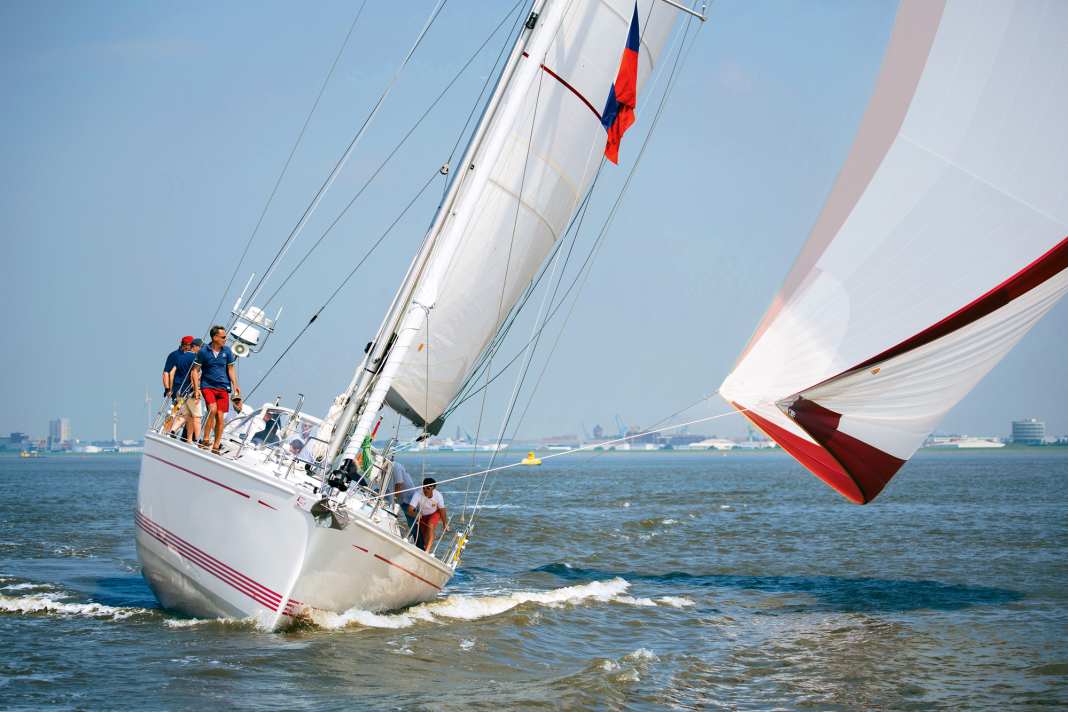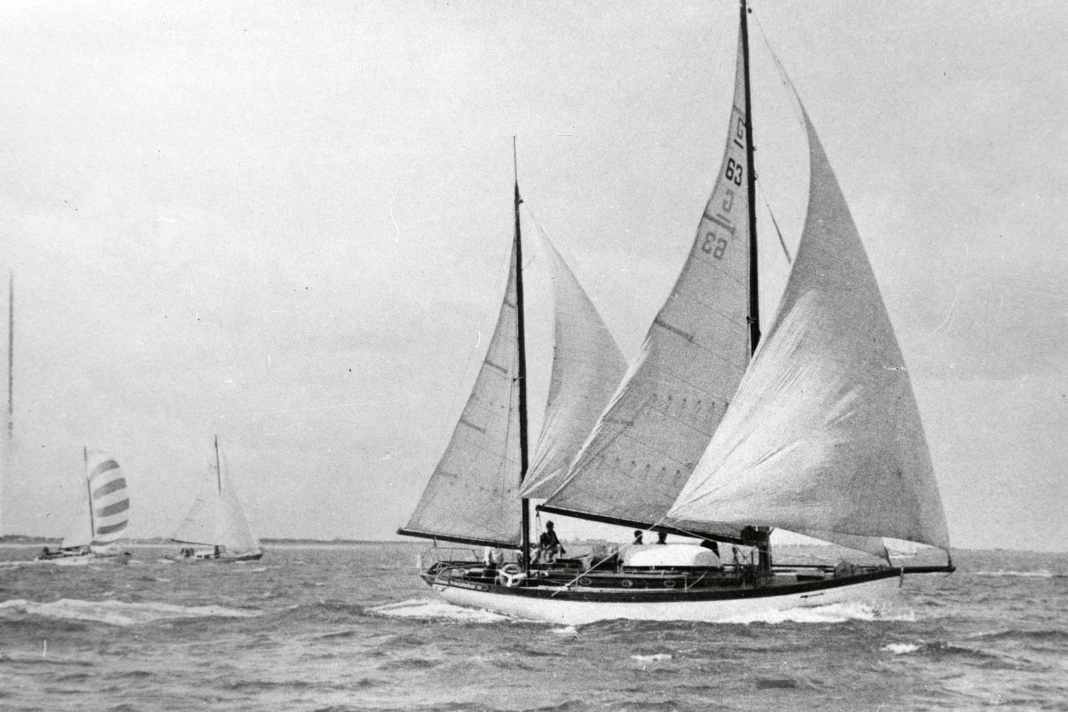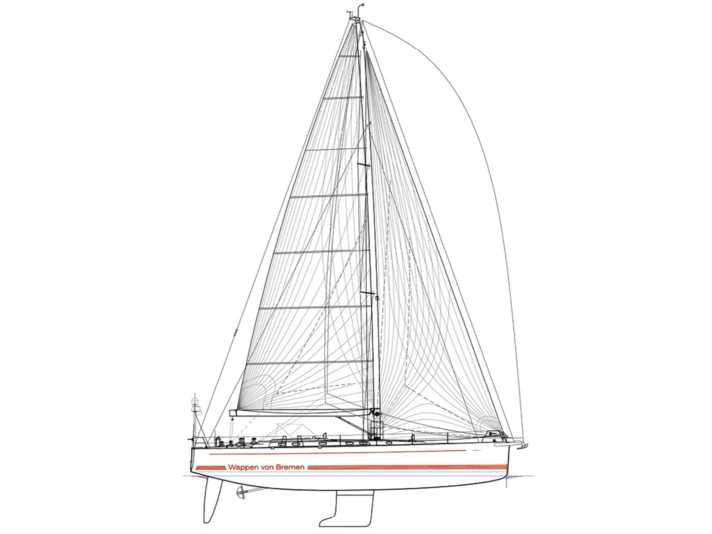





"Nice thing!" When this sentence is uttered, the fourth "Wappen von Bremen" has already completed its first trial run. It has just moored in the new Bremerhaven lock, and a few tourists are standing on the shore watching the hustle and bustle of the harbour and lock. One of the spectators shouts the phrase out into the lock at the top of his voice, as if everyone should be able to hear the words. The new "Wappen" is a beautiful ship: 16.80 metres long, 4.90 metres wide, with the characteristic red stripes and striking lettering on the white hull.
Other special boats:
The new ship is the fourth cruising yacht that has sailed for the sailing club Das Wappen von Bremen since 1934. The long-established Bremen club was founded specifically as a yachting school and has focussed on training ever since. It has two J 70s for the youth and the national league, as well as a veritable regatta boat in the form of the "Bank von Bremen". The members and their guests, on the other hand, take their respective cruising yachts on extended long journeys that can take them as far as Greenland, across the Atlantic and as far as Cape Horn. No trips around the corner, so a ship belonging to the sailing comradeship must not be made of cardboard.
A hard metal structure can do no harm
The "Wappen von Bremen III", a Van de Stadt construction made of 36 millimetre thick cambala wood, has been faithfully serving its purpose for 34 years. Maintenance and care of the ship cost around 60,000 euros every year, and yet after thousands of nautical miles, a general overhaul was due at some point. When it became clear that a modernisation of the club yacht would cost a good 500,000 euros, the sailing club decided in favour of a new build after lengthy discussions.
"There was a large faction in the club that wanted to keep the old ship," says skipper Otto Knechtel about the debates. Designer Torsten Conradi, who ultimately designed the new "Wappen", also explains: "The sailing camaraderie is something special. When the project started, there were many considerations, including from the members. Another new building project? Can't we buy something?" But it soon became clear: "No. You can't buy a boat like this, you have to build it."
The requirements for the new yacht were high: ten crew members had to be able to stay on board comfortably for longer periods of time, they had to be able to move around safely, and the layout and processes had to be right. Conradi: "They are travelling to destinations where no one else wants to go. The boat has to be suitable for this - one of the reasons why we built it in aluminium. We said to ourselves: well, if they're already up there in the Arctic Ocean, then a hard metal structure can't do any harm."
Although the project could also have been realised with plastic, it would have involved much greater effort - and corresponding costs. The SKWB sponsorship organisation is responsible for the material equipment. Non-members are involved here, supporting the association both financially and ideally. The Patenring and the members drummed up support for the project and together finally raised the necessary million for the new building: "We paid for it in cash, without a loan," says sailing master Rudolf Olma with pride. It was all made possible by additional help. The life jackets with AIS transmitters for all crew members were donated, while the teak deck was sponsored by a member of the sailing club.
Compromise between the generations
Once the decision to build a new building had been made, a building committee was appointed. The members discussed, developed and rejected ideas. The challenge: to reconcile the wishes and experience of the older generation with the ideas of the younger generation. "We adopted many of the old solutions," says Otto Knechtel, referring to the cardanic table in the salon, for example: an SKWB speciality that had already proven its worth in the old "Wappen". The table doesn't need a sway bar, but nothing falls off in rough seas. "But of course you can't lean on it."
The seawater pump was more of a topic of discussion. Unnecessary, the younger ones thought. The old salt humpers thought it was indispensable! "On his last tour across the Atlantic, our chairman Jochen Orgelmann had 1200 litres of drinking water in his tank. When they arrived in Barbados, there were still 800 litres left," says Knechtel and has to smile. "People weren't even allowed to brush their teeth with it en route, let alone take a shower. They wanted to mutiny!"
Nevertheless, the older ones prevailed: The pump was installed again. "When our sailing master Rudi Olma in Bremerhaven pumped for the first time and the brown water ran into the sink, we said: And with the Broth do you want to wash the dishes?" They have now made peace like this: The pump is in - albeit blocked by a wooden wedge. No one is likely to use it any time soon, but the older ones are happy.
A marvellous quarrel: the small differences speak volumes. The yacht also reveals how different generations can be - and not just in terms of sailing philosophy.
Innovations on and below deck
Elsewhere below deck, the younger sailors were able to assert themselves again, discussion pointless. Each of the ten berths has its own USB port for charging iPhones, tablets and the like. In addition, a radio has been installed on the new "Wappen" for the first time and - a second toilet! This luxury was particularly controversial in the deliberations of the traditional association. "It's now generally accepted that a wet room makes sense on a long voyage," says designer Conradi with a laugh. But when it came to the second toilet, many members thought it was a waste of space! It was only after Conradi presented a solution that didn't waste any space that the "revolutionary" second toilet was grudgingly accepted by the club's old strategists.
The decisive innovations, however, are naturally to be found on deck. During the first trial voyage, which is also the official handover of the ship to SKWB, all those responsible for the construction are on board alongside the SK skippers. On the way from the berth in the Lloyd Marina to the lock, the new "Wappen" passes the old one: It lies abandoned on the jetty, still ready to sail, of course. But now she has become superfluous; decommissioned.
A quick glance as we pass by, but then the new "Wappen" turns into an adventure playground: fenders need to be stowed, lines need to be cleared. Everything still has to be organised. Alexander Siemer, whose shipyard is responsible for the conversion, quickly mounts the life rafts in their holders on the open stern, Jörg Müller-Arnecke from sailmaker Beilken is ready for the sailing manoeuvres.
"Coat of arms of Bremen" jumps right in
There is a lot to discover and try out. The new "Wappen" has a removable cutter stay and a furling system, which was not available on its predecessor. The huge cockpit is divided into a working area and a living area, with comfortable seating for five people on each dinghy, protected by the large sprayhood with its huge panoramic window. The sprayhood should be flat enough for tall people to look over, but also high enough for smaller crew members to see through the window comfortably. The working area is demarcated by a powerful, central winch for the mainsheet. There are also two further winches for the numerous lines deflected aft.
And they have a lot to offer: a total of ten halyard stoppers are used for reefing lines, dirks, outhauls, kickers, cutter halyards, etc. Apart from Code Zero and the spinnaker halyard, the other halyards are on the mast: "We want to have something to do on the way," comments Rudolf Olma.
While designer Conradi stands at the helm, the sails are tried out one by one. In light to medium winds, the "Wappen" starts right up, the pressure on the rudder is barely noticeable: "Actually, I'm just standing here for the photographer," says Conradi at the helm. Meanwhile, the others are trying to get to grips with the many lines. "What's the green one again?" - "Reef three, I think, right?" No labels have been attached yet, everything will come later; for now, it's time to sail. It doesn't bother anyone that they spend hours travelling back and forth between Bremerhaven and Nordenham: Everyone is busy experiencing their new ship with shining eyes.
"Ship sails, everything on"
The first sheets turn out to be too long, the skippers are almost knee-deep in the cockpit in the wuhling. The pocket knife provides a remedy. "We still need to tidy it up," says Olma. "Everything is redirected here, on the old 'Wappen' everything was at the front of the mast." When the gennaker is recovered, things get hectic for a moment, but the experienced sailors catch the cloth just in time. Tacking, jibing, avoiding freighters and not flicking the buoys - not a good idea with a draught of 2.70 metres on the Weser. The furling system is met with great enthusiasm on this first trip, and the old "Wappen" is always used for comparison. In the past, it was always said: "Changing sails - is that necessary? The genoa is all the way down." Now these words can be heard: "A furling system like this is really something."
Olma looks at the sails with satisfaction. His conclusion of the day: "The ship is sailing, everything is in place."
While some of the skippers are testing the sailing characteristics, they are already busy clearing and stowing below deck. An "engineer's locker" is being set up in good old SK tradition. "That's what we call it. There are spare parts in there, we carry all the parts twice, some even three times, so that we can repair everything on the way," explains Otto Knechtel. The SKWB's so-called boat attendants take care of maintenance. They are responsible for the equipment and take care of replacements if something is missing. However, the lack of spare parts is not really a problem for the SKWB: "We have a lot of hunters and collectors in the club. They say: We can still use that part, even if it's for self-defence," says Knechtel. At the end of the season, a clearance team now has to come on board every year and clear out the ship: "Things like Velcro brushes and lobster tongs have already turned up, and they were promptly removed from the nautical inventory."
Egg liqueur to celebrate the day
Those involved have fond memories of the planning and construction phase: "Everything went off without a hitch," says Rudolf Olma. He and Torsten Conradi are a well-rehearsed team; they also realised the SKWB regatta ship, the "Bank von Bremen", together. The construction committee deliberately chose companies in the region: the aluminium hull of the fourth "Wappen" was welded at the Benjamins yacht yard in Emden, while Siemer-Jachtservice on the Ems took care of the fitting out. During the 14-month construction period, the members were always able to inspect the progress of the work and were in close contact with the shipyards. "Sometimes a whole coach would arrive at our premises in Barßel," says Alexander Siemer. Then there were sandwiches and his homemade egg liqueur while the project was discussed.
The egg liqueur is also available today, Alexander Siemer has brought a large bottle to celebrate the day. And after the "Wappen" number four has moored again in the Lloyd Marina, the last signatures flow onto the paper. Then the shipyard stander is hauled in and the flag of the sailing comradeship is ceremoniously hoisted. And soon the brand new yacht will set off on its first voyage, across the North Sea to the Baltic. With a USB connection, music and two toilets on board, the traditional Bremen club is sailing into a new era. Nice thing.
From the Weser to the world






The sailing comradeship Das Wappen von Bremen was founded in 1934 and has been dedicated to training ever since. With their long-distance sailing yachts, the members and guests repeatedly undertake trips to remote areas. In addition to the North Sea and Baltic Sea, Atlantic crossings and Caribbean cruises, even the Arctic Ocean is among the destinations. Over the course of various completed voyages, members can progress from simple crew member to watch leader to skipper - the latter entitles them to sail the club yacht "Wappen von Bremen". The club also maintains the regatta ship "Bank von Bremen" as well as two J 70s for the German Sailing League and several dinghies.
Technical data "Coat of arms of Bremen"

- Design engineer: Judel/Vrolijk & Co
- Torso length: 16,80 m
- Waterline length: 15,80 m
- Width: 4,90 m
- Depth: 2,70 m
- Mast height: 24,30 m
- Displacement: 20 t
- Ballast: 7 t
- Mainsail: 87 m²
- Genoa: 76 m²
This article was first published in 2016.

